VOLVO 1800 ES User Manual
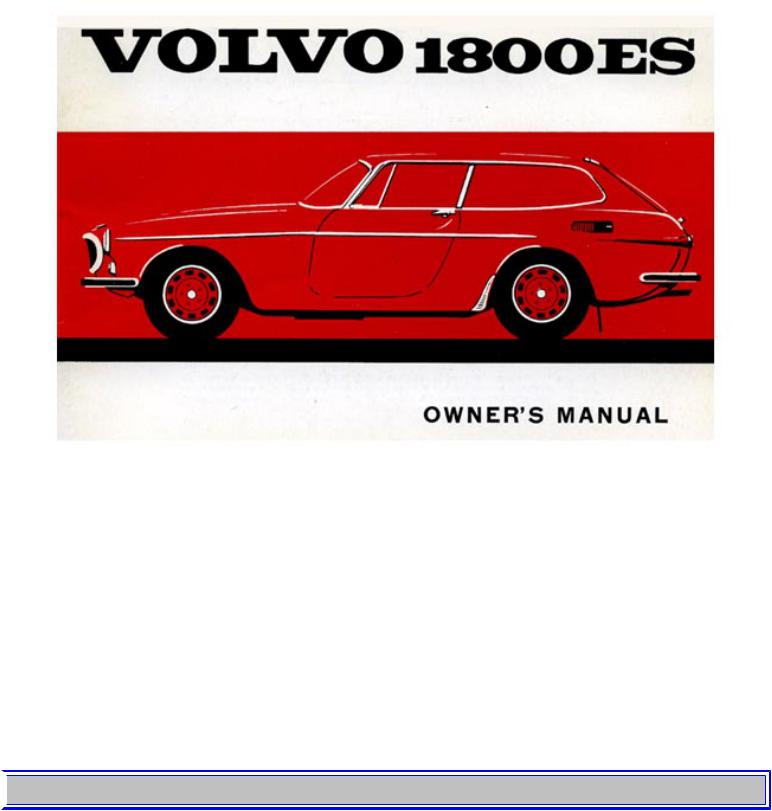
1973 Volvo 1800 ES
1 9 7 3 VOLVO 1800 ES
Notice to Owner: Your Volvo has been built to comply with all North American safety and anti-pollution regulations and evidence of this can be seen from the certification label attached on the door opening sheet metal and in the engine compartment. For further information regarding these regulations, please talk to your selling dealer.
Volvo 1800 ES
Operating Instructions - Description - Servicing
AB VOLVO - GOTEBORG, SWEDEN
Reproduction permitted if source is quoted
 pg. 2
pg. 2
http://new.volvocars.com/ownersdocs/1973/1973%201800/731800_00.htm (1 sur 5) [2013-03-14 11:51:29]
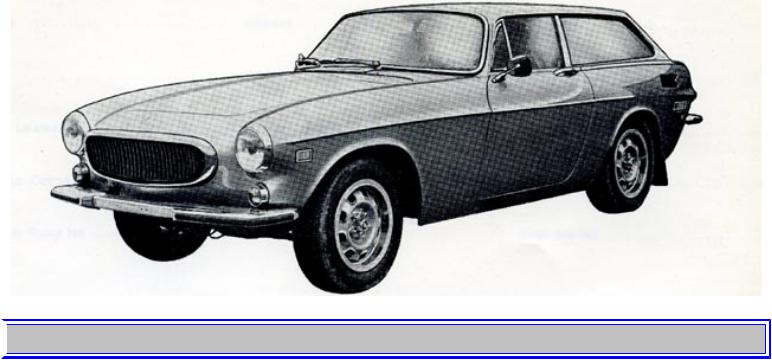
1973 Volvo 1800 ES
 pg. 3 CONTENTS
pg. 3 CONTENTS
INTRODUCTION |
|
Volvo Service Organization |
5 |
Warranty and Service Booklet |
5 |
Service Inspections |
5 |
Type Designations |
6 |
OPERATING INSTRUCTIONS |
|
Instruments and controls |
9 |
Interior and body |
18 |
Starting and driving |
26 |
Running-in |
26 |
Starting the engine |
27 |
Shifting, manual transmission |
27 |
Shifting, automatic transmission |
28 |
Towing |
30 |
Braking |
30 |
TECHNICAL DESCRIPTION |
|
Engine compartment |
32 |
Engine |
33 |
Power train |
35 |
Front end and steering |
37 |
Heating system |
37 |
Electrical system |
38 |
Brakes |
40 |
SERVICING |
|
General |
41 |
Maintenance schedule |
42 |
http://new.volvocars.com/ownersdocs/1973/1973%201800/731800_00.htm (2 sur 5) [2013-03-14 11:51:29]

1973 Volvo 1800 ES |
|
When filling the tank |
44 |
Lubrication |
45 |
Oil changes |
46 |
Engine |
50 |
Electrical system |
54 |
Power transmission |
60 |
Brakes |
60 |
Front end |
60 |
Wheels and tires |
61 |
Body |
63 |
Long-distance trip |
65 |
Cold weather |
66 |
Lubricating chart |
77 |
FAULT TRACING |
68 |
SPECIFICATIONS |
|
Measurements and weights |
70 |
Engine |
70 |
Electrical system |
72 |
Power train |
72 |
Front wheel geometry |
73 |
Wheels and tires |
73 |
Capacities |
73 |
Tools |
73 |
CONSUMER INFORMATION 74 |
|
INDEX |
78 |
 pg. 4 FOREWORD
pg. 4 FOREWORD
Before you start driving your new Volvo please read through this manual carefully. It contains all the information you need to be able to drive and service your vehicle in the best possible way. By following the instructions given in this manual you will find that your Volvo will come up to all the expectations concerning economical operation and excellent performance that you have every right to expect of a top-quality vehicle.
This is not intended to be a comprehensive technical manual and does not claim to make the reader a perfect car
http://new.volvocars.com/ownersdocs/1973/1973%201800/731800_00.htm (3 sur 5) [2013-03-14 11:51:29]

1973 Volvo 1800 ES
mechanic. It will, however, show you how to look after your vehicle so that trouble in the future can be avoided. The better you know your Volvo, the better service it can give you. Even for an experienced motorist it can contain some valuable information.
For a more detailed mechanical description and repair procedures, we refer you to the special Service Manual for the car which can be purchased from the dealer.
 pg. 5 INTRODUCTION
pg. 5 INTRODUCTION
Volvo Service Organization
To get the most out of the invested capital represented by a car, it must be looked after and serviced regularly. Volvo has gone to a great deal of trouble in the design and selection of material to ensure that the car in question only requires a minimum of servicing. We rely, however, on your co-operating with regard to the future maintenance of your vehicle. To help you with this, Volvo has built up a world-wide service organization. All Volvo dealers have specially trained personnel and receive a continuous supply of technical information from the Volvo Service Organization concerning repairs and adjustment. They also have special tools, designed at the Volvo factory. Moreover all Volvo dealers have a comprehensive stock of parts which is a guarantee that the part you get is genuine Volvo.
That is why our dealers are in the best possible position to give your vehicle first-class service concerning both maintenance operations and repairs. You should also refer to your dealer for any information about your Volvo that is not included in this manual. Volvo not only has workshops within easy reach in your own country, it also has a widely distributed service network in other countries.
Warranty and Service Booklet
A warranty and service booklet accompanies each vehicle when it is delivered. This booklet contains a coupon entitling you to a service inspection after 1,500 miles (2,500 km). If possible, let the dealer who supplied the vehicle carry out this service inspection. Any of our dealers, however, can do this if required.
If our guarantee is to apply, we make one absolute condition and that is that the above-mentioned inspection is carried out at roughly the mileage shown and that the vehicle has been looked after in accordance with the instructions given in this manual.
Service Inspections
After the 1,500 miles (2,500 km) service inspection has been carried out, you should come to some arrangement with your dealer concerning continued, regular service inspections in accordance with the suggestions made in our Service Book. Thorough and regular servicing is of vital importance for the performance and length of life of the vehicle.
Always use genuine Volvo parts.
 pg. 6 CONTENTS
pg. 6 CONTENTS
http://new.volvocars.com/ownersdocs/1973/1973%201800/731800_00.htm (4 sur 5) [2013-03-14 11:51:29]
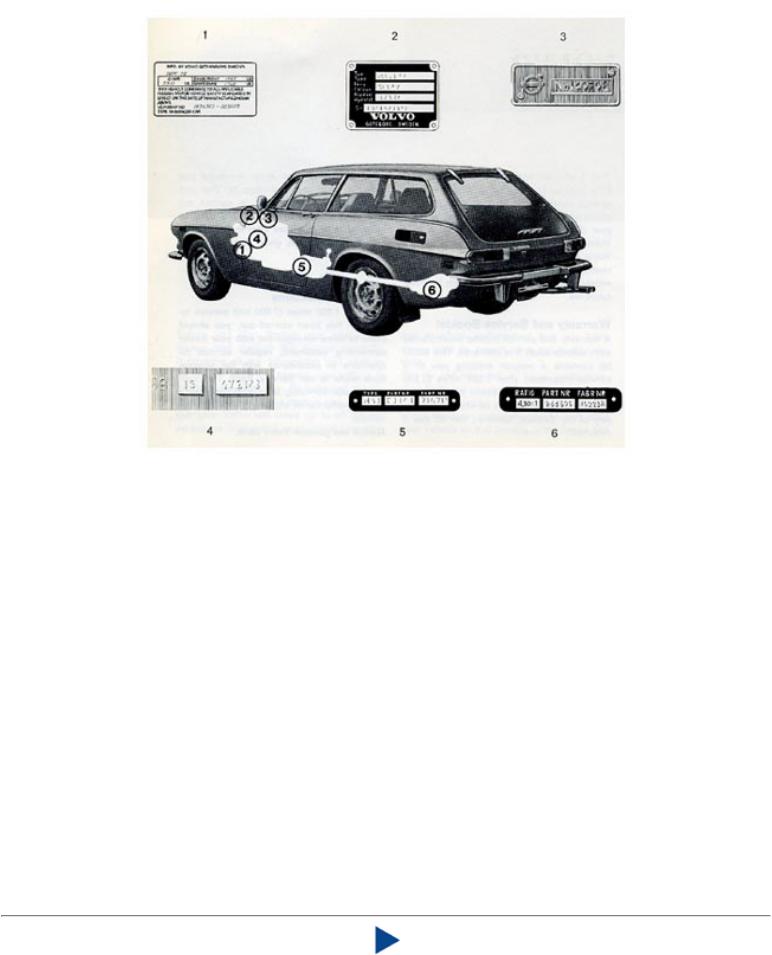
1973 Volvo 1800 ES
Type designations
This manual deals with the Volvo 1800 ES, 1973 model.
In all correspondence concerning your vehicle with the dealer and when ordering parts, the V.I.N. and engine number should always be quoted.
1.V.I.N. (Vehicle Identification Number) plate located at the foot, left door post. The V.I.N. number is also stamped on right door pillar.
2.Vehicle type designation, code number for color and upholstery.
3.Body number.
4.Type designation, serial number and part number of engine: stamped on engine left-hand side. The final figures of the part number are stamped on a plate. The serial number then follows with all its figures stamped on the block.
5.Type designation, serial number and part number of transmission: underneath transmission.
6.Final drive reduction ratio, part number and serial number: on a plate on final drive.
Top of Page
http://new.volvocars.com/ownersdocs/1973/1973%201800/731800_00.htm (5 sur 5) [2013-03-14 11:51:29]
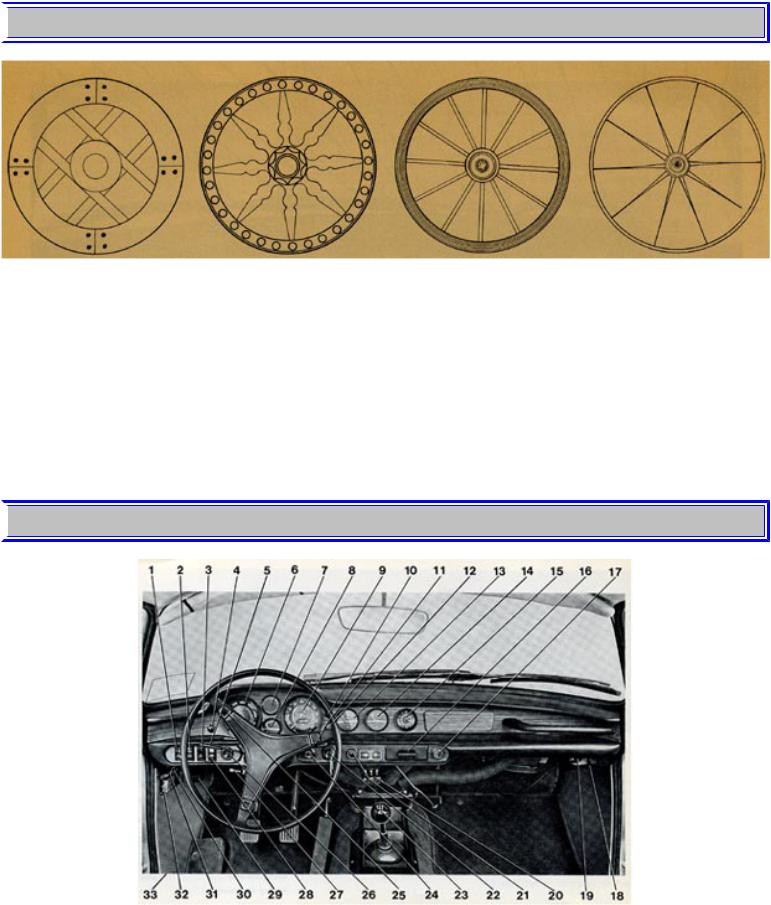
1973 Volvo 1800 ES
1 9 7 3 VOLVO 1800 ES
 pg. 7 OPERATING INSTRUCTIONS
pg. 7 OPERATING INSTRUCTIONS
Before starting to drive your car get to know where the instruments and controls are located.
After starting the car and now and again during driving always make a habit of checking to see that the instruments are functioning normally.
This chapter OPERATING INSTRUCTIONS contains the following:
Instrument and controls page 9
Interior and body |
page 18 |
Starting and driving |
page 26 |
 pg. 8 OPERATING INSTRUCTIONS
pg. 8 OPERATING INSTRUCTIONS
http://new.volvocars.com/ownersdocs/1973/1973%201800/731800_01.htm (1 sur 28) [2013-03-14 11:51:48]

1973 Volvo 1800 ES
 pg. 9 OPERATING INSTRUCTIONS
pg. 9 OPERATING INSTRUCTIONS
INSTRUMENTS AND CONTROLS
1 Switch for windshield wipers
2 Switch for windshield washer
3 Switch for fan
4 Warning lamp, parking brake and brake circuits
5 Lever for turn indicators, dipped headlights and fullbeam flashers 6 Rev counter
7 Temperature gauge, engine oil
8 Temperature gauge, coolant
9 Speedometer (combined instrument)
10 Warning lamp, overdrive
11 Overdrive operating lever
12 Reminder lamp for seat belts
13 Oil pressure gauge
14 Fuel gauge
15Clock
16Ashtray
17Cigarette lighter
18Switch for map reading light
19Controls for direct ventilation
20Controls for heating and ventilation
21Lighting switch
22Ignition switch and steering wheel lock
23Shift lever
24Instrument panel light switch
25Horn
26Switch for warning hazard signal flashers (4 signals flash simultaneously)
27Trip odometer reset knob
28Switch for electrically heated rear window
29Hood release handle
30Control for direct ventilation
31Dimmer for fullbeams and overdrive warning lamps
32Fuses
33Parking Brake
The instruments and controls are described in more detail in the following pages with a reference to the numbers in the picture opposite.
1 Switch for windshield wipers
http://new.volvocars.com/ownersdocs/1973/1973%201800/731800_01.htm (2 sur 28) [2013-03-14 11:51:48]
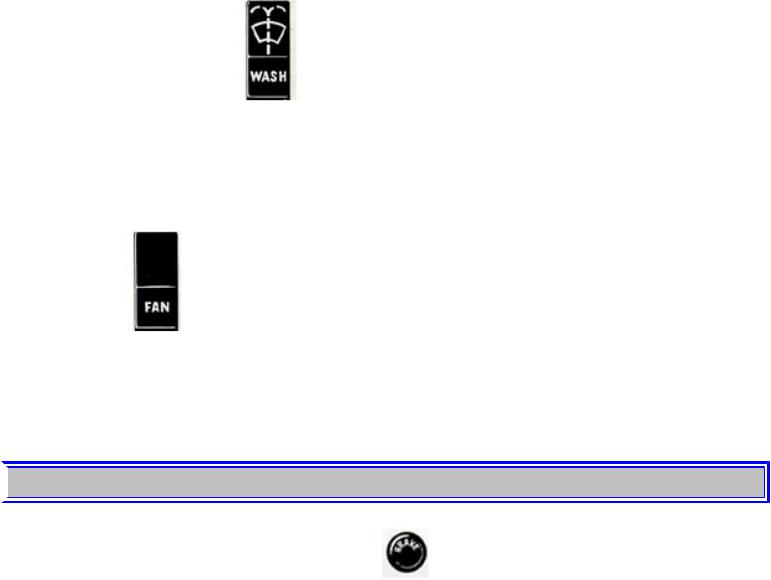
1973 Volvo 1800 ES
The windshield wipers are operated electrically and can be driven at two different speeds. Depressing the lower part of the rocker switch operates the wipers at normal speed, which is recommended for normal driving in rainy weather or snow. By depressing the switch further, the wipers will operate at full speed. This is recommended only when driving in heavy rain or driving at high speed in the rain.
Depressing the upper part of the switch will return the wipers to their park position.
2 Switch for windshield washer
The windshield washer is engaged by depressing the lower part of the rocker switch. The washer can be used even when the wipers are disengaged. The washer is switched off simply by taken the thumb or finger off the switch. The fluid container for the washer is located in the engine compartment and contains about 1.6 US qts./1.3 Imp. qts. (1.5 liters).
3 Switch for fan
A rocker switch operates the fan for the heating and ventilation system. The fan is driven at full speed when the lower part of the switch is depressed one step. Depressing it further will operate the fan at half speed. Due to the aerodynamic design of the car, the overpressure in the heater air intake is relatively small. At low car speed, therefore, the fan should be operated at full speed if maximum air capacity is desired.
 pg. 10 OPERATING INSTRUCTIONS
pg. 10 OPERATING INSTRUCTIONS
4 Warning lamp, parking brake and brake circuits
This lamp goes on with a steady red light when the parking brake is applied and the ignition switch is on. The lamp also functions as a warning lamp if one of the brake circuits should stop functioning. If the lamp lights up while the car is being driven, take it to a workshop without delay for a check on the brake system. Drive carefully under such conditions.
http://new.volvocars.com/ownersdocs/1973/1973%201800/731800_01.htm (3 sur 28) [2013-03-14 11:51:48]
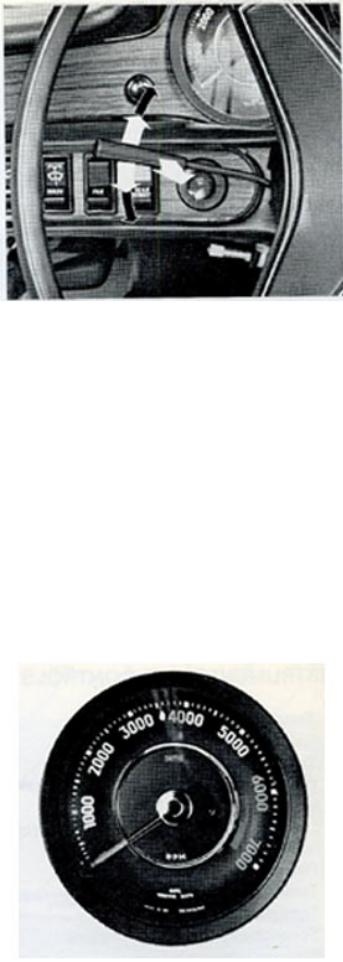
1973 Volvo 1800 ES
5 Lever for turn indicators, dipped headlights and fullbeam flasher
All the above-mentioned functions are operated by means of the lever to the left in front of the steering wheel. Moving the lever upwards operates the right-hand turn indicator, and moving it downwards will operate the left-hand turn indicator.
The lever has a so-called "pressure" point to be used when changing lanes. This means that when turning the steering wheel slightly (changing lanes, bypassing), move the lever up or down to the pressure point position and hold it there with the hand. The right or the left turn indicator will start signalling (see white arrows in picture). When the lever is released, it returns automatically to neutral position. For normal swings, move the lever past the pressure point position all the way (black arrows in picture). The lever returns to neutral position when the steering wheel straightens up.
To switch from fullbeam to dipped beam and vice-versa, move the lever backwards towards the steering wheel and then release it. Here the lighting switch (21) should be pulled out fully.
The lever is also used for flashing with main beam when the headlights are not switched on. The headlight fullbeam is operated by moving the lever towards the steering wheel and it will remain switched on until the lever is released.
6 Revolution counter
The revolution counter indicates engine speed in revolutions per minute. The marked area between 6,000 and
http://new.volvocars.com/ownersdocs/1973/1973%201800/731800_01.htm (4 sur 28) [2013-03-14 11:51:48]

1973 Volvo 1800 ES
6,500 rpm means that this engine speed is permitted only for very short periods. The engine speed range 6,500- 7,000 rpm, which is marked completely in red, should not be used.
 pg. 11 OPERATING INSTRUCTIONS
pg. 11 OPERATING INSTRUCTIONS
7 Oil temperature gauge
The oil temperature depends on engine speed and loading and can vary to a great extent. While the car is being driven, the pointer should remain within the green area and should not be permitted to go into the red area.
During cold weather and for short drives when the engine has not reached a high temperature, it may happen that the gauge pointer does not swing into the green sectors.
8 Coolant temperature gauge
The temperature gauge shows the temperature of the coolant and thus indicates the working temperature of the engine. During driving the pointer should normally stay within the two central green areas. During town
http://new.volvocars.com/ownersdocs/1973/1973%201800/731800_01.htm (5 sur 28) [2013-03-14 11:51:48]
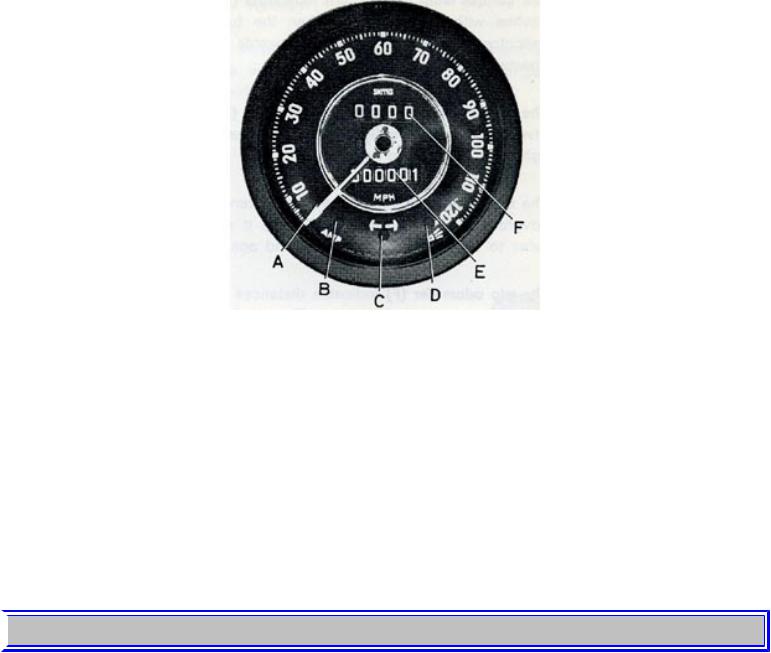
1973 Volvo 1800 ES
driving and idling when the weather is particularly hot it is permitted for the temperature gauge pointer to enter the red-lined field.
If the pointer should enter the solid red field repeatedly, check the coolant level and fan belt tension.
9 Speedometer (combined instrument)
ASpeedometer
BWarning lamp for battery charging
CControl lamp for turn indicators
DControl lamp for headlight fullbeams
EOdometer
FTrip odometer
The warning lamp for battery charging (B)
goes on with a steady red light when the battery is discharging. If this lamp should light up during driving, there is either something wrong with the electrical system or there is insufficient fan belt tension so that the belt slips on the alternator pulley, causing poor charging.
 pg. 12 OPERATING INSTRUCTIONS
pg. 12 OPERATING INSTRUCTIONS
The control lamp for the turn indicators (C) flashes with a green light when the turn indicator lever switch is moved upwards or downwards.
The control lamp for headlight fullbeams (D) gives a steady blue light when the headlights are switched to fullbeam.
The mileometer (E) shows the total distance covered in miles. After 999999 miles it returns to zero and starts to go round again.
The trip odometer (F) indicates distances of up to maximum 999 miles. The window furthest to the right is graduated in tenths of a mile and can thus be used to measure short distances. The trip odometer is set to zero by pushing in the reset knob (27) under the dashboard.
http://new.volvocars.com/ownersdocs/1973/1973%201800/731800_01.htm (6 sur 28) [2013-03-14 11:51:48]
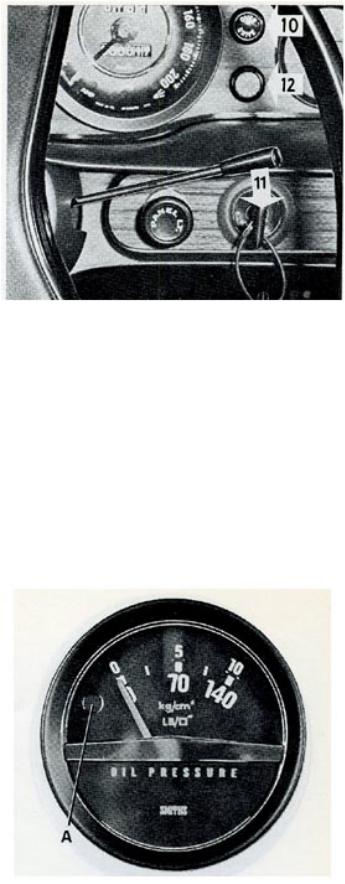
1973 Volvo 1800 ES
10, 11 Warning lamp, lever for overdrive
The overdrive is engaged by moving downwards the lever. This switches on the warning lamp (10), which remains on as long as the overdrive is engaged. To disengage the overdrive move the lever upwards, see also page 28.
12 Seat belt reminder lamp
This lamp goes on and a buzzer starts buzzing if the driver and front-seat passenger do not fasten their seat belts before driving.
The reminder light and warning buzzer are wired via a contact in the transmission and function only when the ignition is switched on and one of the speeds 1-4 (manual transmission) and 1, 2, D (automatic transmission) are engaged.
13 Oil pressure gauge
A Warning lamp for oil pressure
The oil pressure gauge indicates the pressure of the oil in the engine lubricating system. Oil pressure is dependent upon engine speed and the temperature of the oil as well as its viscosity.
Normally oil pressure can vary during driving between 35 and 85 psi (2.5 and 6.0 kp/cm2). After very hard driving the oil pressure at idling speed can go down to about 7 psi (0.5 kp/cm2) and the warning lamp in the
http://new.volvocars.com/ownersdocs/1973/1973%201800/731800_01.htm (7 sur 28) [2013-03-14 11:51:48]
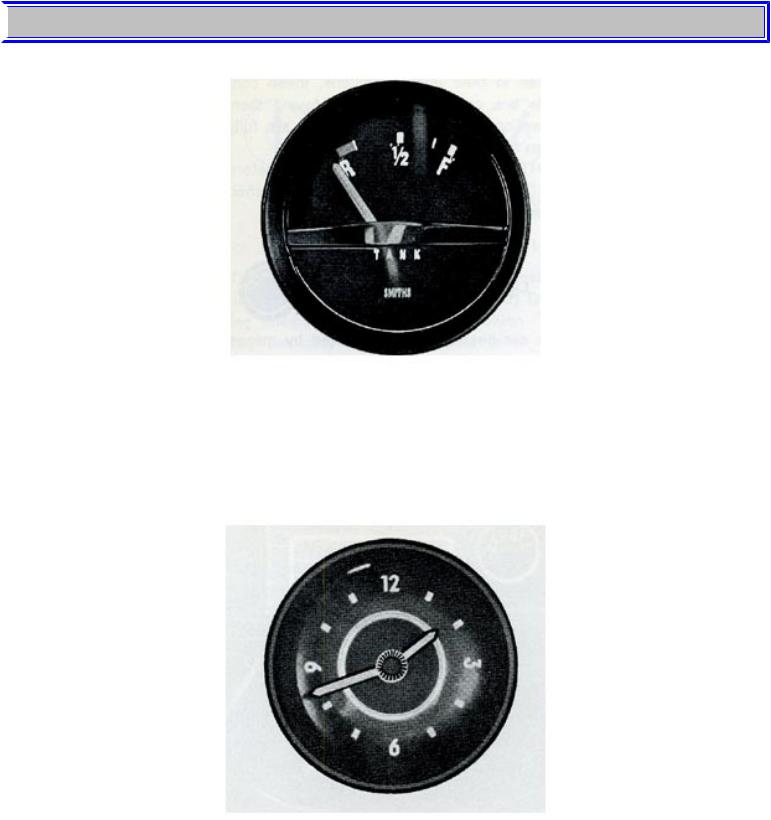
1973 Volvo 1800 ES
oil pressure gauge lights up. This is quite normal providing the pressure goes up again when engine speed increases. If the warning lamp should light up during driving, stop the engine immediately and find out the reason for this.
 pg. 13 OPERATING INSTRUCTIONS
pg. 13 OPERATING INSTRUCTIONS
14 Fuel gauge
The fuel gauge indicates approximately the amount of fuel in the tank. The red field at "R" (reserve) is a reminder that the tank should be filled. When the gauge pointer is on "Reserve"' there are approx. 1.6 US galls/1.3 Imp. galls (6 liters) left in the tank. The fuel tank has a capacity of approx. 11 US galls/10 Imp. galls (45 liters). The gauge functions when the ignition is switched on.
15 Clock
The clock is electrically driven. It is set by first pressing in the adjusting knob and then turning the hands to the actual time.
16 Ashtray
http://new.volvocars.com/ownersdocs/1973/1973%201800/731800_01.htm (8 sur 28) [2013-03-14 11:51:48]
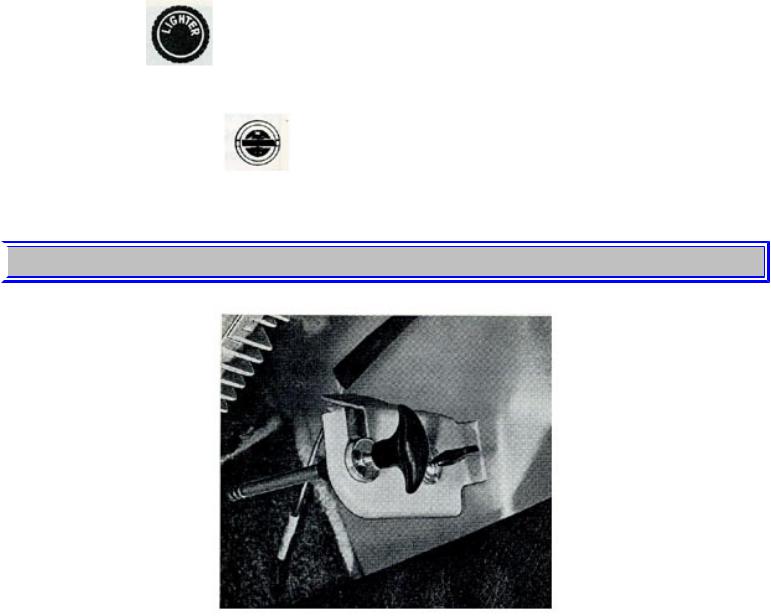
1973 Volvo 1800 ES
To empty the ashtray, pull it straight out all the way while pressing down the tongue inside with the thumb.
17 Cigarette lighter
To use the cigarette lighter, push it in. The lighter releases automatically when it attains sufficient heat.
18 Switch, map reading lamp
The map reading lamp is located to the right under the dashboard and is switched on by flicking the switch upwards.
 pg. 14 OPERATING INSTRUCTIONS
pg. 14 OPERATING INSTRUCTIONS
19, 30, Controls for direct ventilation
For direct ventilation there is a louver on the right-hand side and also one on the left-hand side. To open the louver, pull out the handle horizontally to the desired position and lock it by giving it a quarter turn.
http://new.volvocars.com/ownersdocs/1973/1973%201800/731800_01.htm (9 sur 28) [2013-03-14 11:51:48]

1973 Volvo 1800 ES
20 Heater and ventilation controls
The left-hand control "FLOOR" controls the flow of air to the floor. The central control "DEFR" controls the flow of air to the windshield. The right-hand control "TEMP" controls the temperature of the incoming air. When in their upper positions, these controls are completely closed. Moving them down opens them gradually, They are fully open in their bottom position.
NOTE. A brief moment will elapse before the desired temperature has been reached after adjustment of the controls.
Mist on windows
Normally the through-ventilation takes good care of the de-misting of the rear window and side windows. However, should misting arise during cold and damp weather, this can be removed very easily in the following way: Set the fan switch and defroster control to full output and shut off the control FLOOR. Switch on the heating for the rear window. Especially during the wintertime also make sure water does not collect on the floor and under the mats as this increases the humidity which would eventually cause misting.
21 Lighting switch
The car headlights are operated by means of a push-pull type switch on the dashboard as well as the lever (5) on the steering column. All the lighting is switched off when the dashboard switch is pushed in all the way. Pulling it out to the first notch, switches on the parking lights, and when it is fully out, the full or dipped headlights are switched on. Switching from full to dipped headlights is done by means of the lever (5).
The lighting is not connected over the ignition switch. So the lighting will function whether or not the ignition key is in position.
Your car is fitted with side marker lights. These are located on the sides of the mudguards and are switched on by pulling out the switch knob for the headlamp lighting.
 pg. 15 OPERATING INSTRUCTIONS
pg. 15 OPERATING INSTRUCTIONS
http://new.volvocars.com/ownersdocs/1973/1973%201800/731800_01.htm (10 sur 28) [2013-03-14 11:51:48]
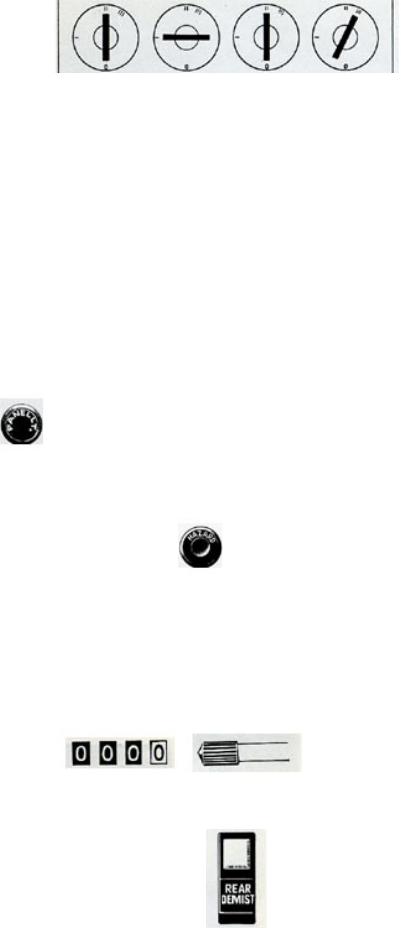
1973 Volvo 1800 ES
22 Ignition switch and steering wheel lock
The key has four positions: (0) Locked position, (1) Intermediate position, (2) Driving position and (3) Starting position. The key can only be inserted and taken out in the locked position. The steering wheel automatically locks when the key is removed.
The ignition switch is provided with a buzzer to warn the driver should he forget to remove the ignition key when his door is opened.
In the intermediate position, the electrical system of the car is switched on with the exception of the ignition system. The steering wheel is not locked.
The driving position is the position in which the key is when the car is being driven. To start the engine, turn the key to the starting position and this automatically engages the starter motor. As soon as the engine starts, release the key which will then automatically return to the driving position.
If the car is parked in such a way as to make it difficult to unlock the steering wheel, unlocking can be made easier by slightly turning the steering wheel one way and then the other.
24 Panel light switch
Turning the knob to the right increases tho lighting on the instrument panel, turning to the left decreases it. The lighting switch (21) must be pulled out.
26 Switch for warning hazard signal flashers
When this switch is pushed in, all the turn indicators start flashing simultaneously. A control lamp mounted in the switch blinks in unison. The warning system is not connected across the ignition switch. This means that it functions whether the ignition key is in position or not.
The warning hazard signal flashers are only to be used when you have to park the car in such a way that there may be danger for other road users.
Do not forget that rules and regulations for the use of these flashers can vary from place to place.
27 Trip odometer reset knob
To zero-set the trip odometer turn the knob clockwise. Turn until the figure 0 appears in all the windows.
28 Switch for electrically heated tailgate window
The Volvo 1800 ES is fitted with an electrically heated tailgate window in order to provide clear vision rearwards in cold and damp weather.
Heating is done by means of wires on the inside of the rear window. Avoid placing anything near the wires that might damage them.
The heating is switched on by depressing the lower part the rocker switch. This causes a warning light in the
http://new.volvocars.com/ownersdocs/1973/1973%201800/731800_01.htm (11 sur 28) [2013-03-14 11:51:48]
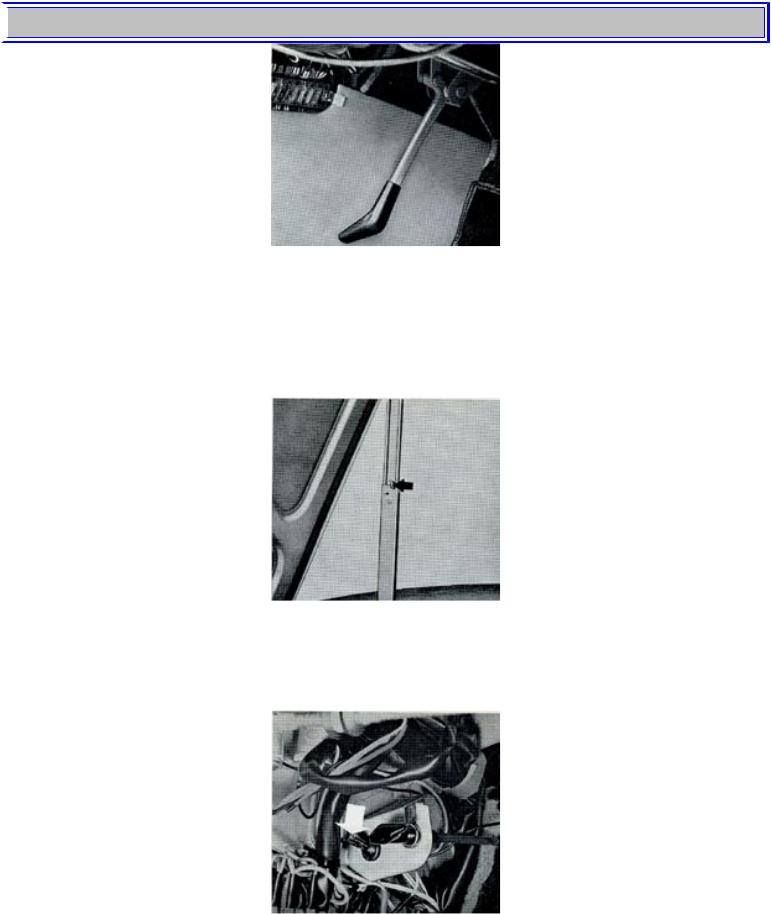
1973 Volvo 1800 ES
switch to go on. Depressing the upper part of the switch shuts off the heating.
Shut off the heating when the tailgate window has become free from mist and ice in order not to load the battery unduly.
 pg. 16 OPERATING INSTRUCTIONS
pg. 16 OPERATING INSTRUCTIONS
29 Hood release handle
The hood is fitted with a locking catch which is released from the driving seat by means of a handle to the left under the dashboard. Moving this handle forwards and downwards will release the hood. The hood is retained in its lifted position by a rod which automatically locks through a built-in retainer when the hood is lifted all the way up.
To lower the hood, press in the retainer, lift the hood to its outer position and let it drop down.
The level of the hood can be adjusted if necessary by screwing out or in the rubber plugs on brackets in front of the windshield.
31 Dimmer for fullbeams and overdrive warning lamps
http://new.volvocars.com/ownersdocs/1973/1973%201800/731800_01.htm (12 sur 28) [2013-03-14 11:51:48]
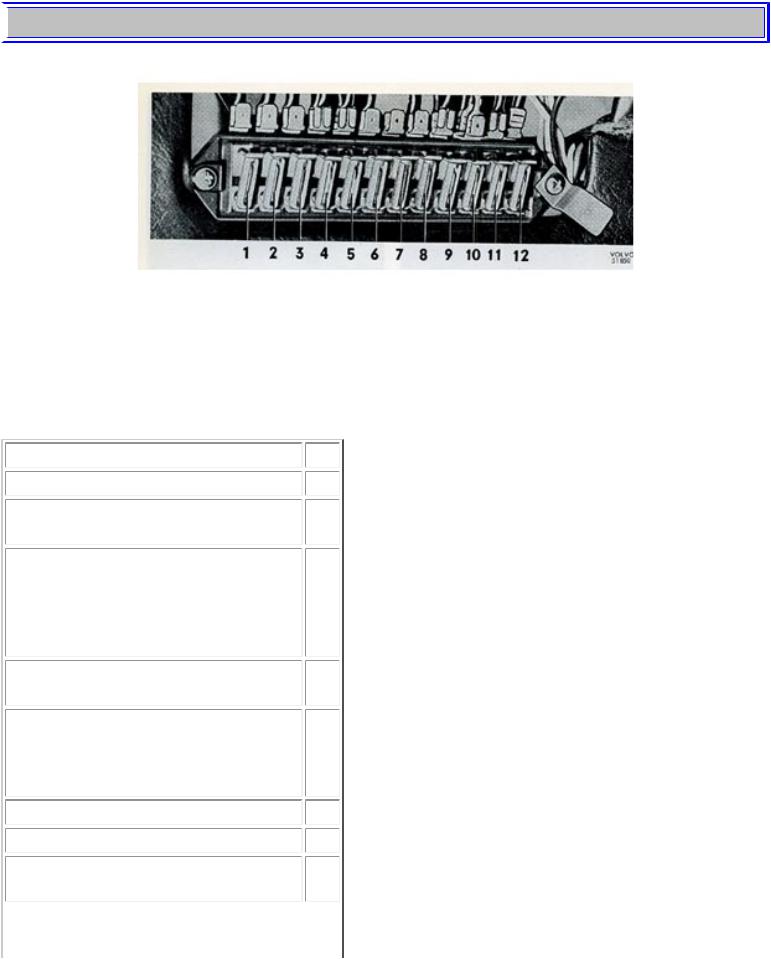
1973 Volvo 1800 ES
During long trips in darkness, the warning lamp for fullbeams and overdrive can be irritating. The glare from these can be dimmed by moving the control to the lower position. The dimmer is off when the control is in the upper position.
 pg. 17 OPERATING INSTRUCTIONS
pg. 17 OPERATING INSTRUCTIONS
32 Fuses
The electrical equipment is protected by means of a number of fuses in a fusebox. If a fuse has to be replaced, always make sure that you use the right type of fuse. If fuses blow repeatedly, do not replace with a fuse of higher rating but have a workshop check the electrical system.
Always have spare fuses in the car.
1 |
Booster fan |
8 A |
|
2 |
Windshield wipers - washers |
8 A |
|
3 |
Cigarette lighter |
8 A |
|
Overdrive (M41) |
|||
|
|||
4 |
Flashers |
|
|
Warning lamps, brakes, charging |
|
||
oil pressure |
5 A |
||
Instruments |
|
||
Light, seat belts |
|
||
5 |
Relay for elec. heated tailgate window |
|
|
Relay for fuel pump |
|
||
6 |
Horn relay |
|
|
Reminder light and |
8A |
||
buzzer, seat belt |
|||
|
|||
Back-up light |
|
||
7 |
Spare |
16A |
|
8 |
Elec. heated tailgate window |
16A |
|
9 |
Brake lights |
8A |
|
Electric clock |
|||
|
|||
http://new.volvocars.com/ownersdocs/1973/1973%201800/731800_01.htm (13 sur 28) [2013-03-14 11:51:48]
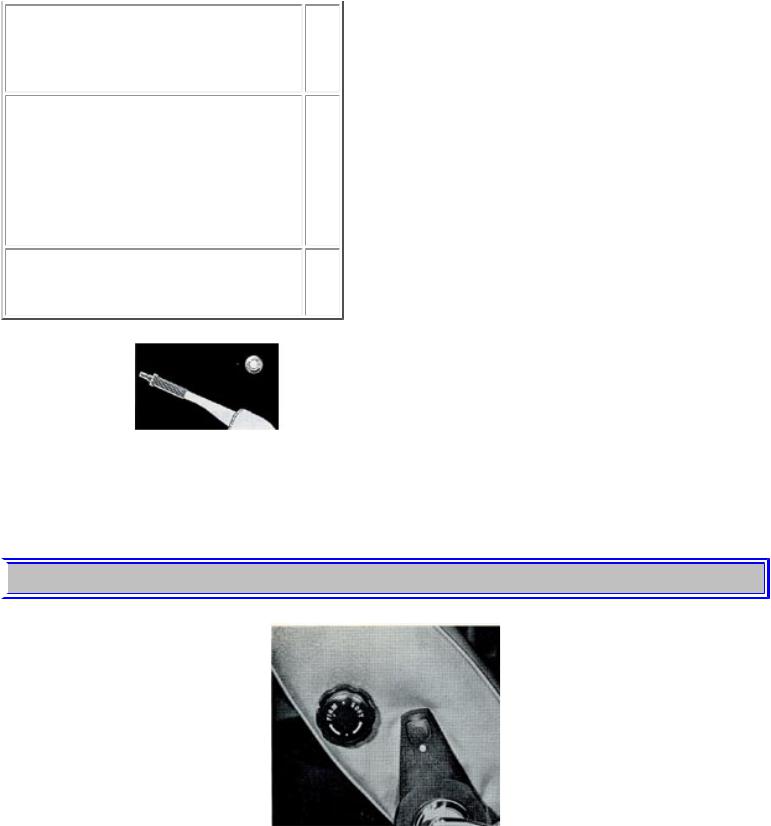
1973 Volvo 1800 ES
10 Map reading lamp
Warning buzzer, ignition key
5A
Interior lighting Dimmer relay
11 Instrument panel light
Rear light, left, and side marking light License plate light
Parking light, left, and side 5A marking light
Light, heater controls Light, switches
12 Rear light, right, side marking light Parking light, right, side marking light 5A Shift positions light (BW35 autom. trans.)
33 Parking brake
The parking brake lever is located immediately to the left of the driving seat. It operates on the rear wheels only. When the parking brake is applied and the ignition is on, a red warning lamp lights on the instrument panel. Remember that the footbrake warning system is also connected to this lamp. Should it light when the parking brake is not on, this may be due to a failure in one of brake circuits. In such a case drive immediately (but with due care) to a workshop for a check.
 pg. 18 OPERATING INSTRUCTIONS
pg. 18 OPERATING INSTRUCTIONS
INTERIOR AND BODY
Front seats Lumbar supports
Both front seats are fitted with adjustable lumbar supports. Adjustment is carried out by means of a knob on the inside of the backrest. To tension the lumbar support, and thus exert more pressure against the small of the back, turn the knob clockwise, "FIRM", and to relieve the pressure against the small of the back, turn the knob counter-clockwise, "SOFT".
http://new.volvocars.com/ownersdocs/1973/1973%201800/731800_01.htm (14 sur 28) [2013-03-14 11:51:48]
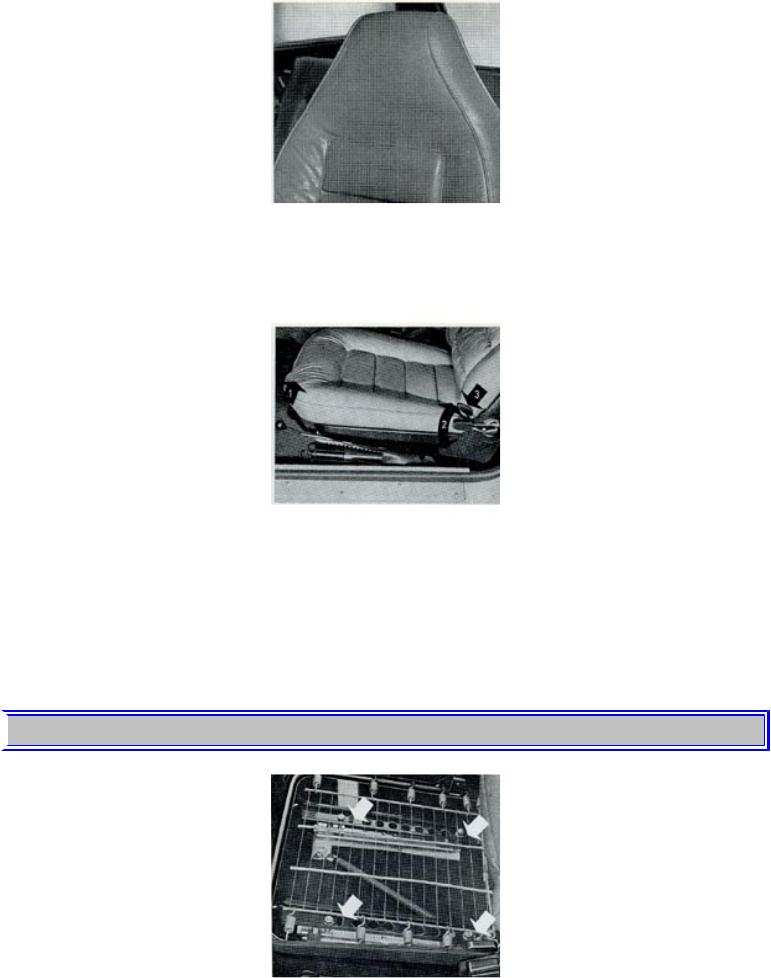
1973 Volvo 1800 ES
Head restraints
The front seats form one piece with the head restraints which are there to protect the neck when abrupt stops are made.
Front seat adjustment
The front seats can be adjusted backwards and forwards by moving the handle (1) sideways towards the center of the car. Brace the feet against the floor and adjust the seat to the most comfortable position. Backrest inclination is infinitely adjustable by means of the arm (2).
The easiest way to adjust the backrest is to lighten pressure against the backrest before adjusting with the arm. There is also a latch (3) for the backrest. Releasing this latch enables the backrest to be folded forwards, e.g., to get into the rear seat.
 pg. 19 OPERATING INSTRUCTIONS
pg. 19 OPERATING INSTRUCTIONS
The seat can also be adjusted lengthwise over and above that allowed by the latch fittings. This is done by
http://new.volvocars.com/ownersdocs/1973/1973%201800/731800_01.htm (15 sur 28) [2013-03-14 11:51:48]
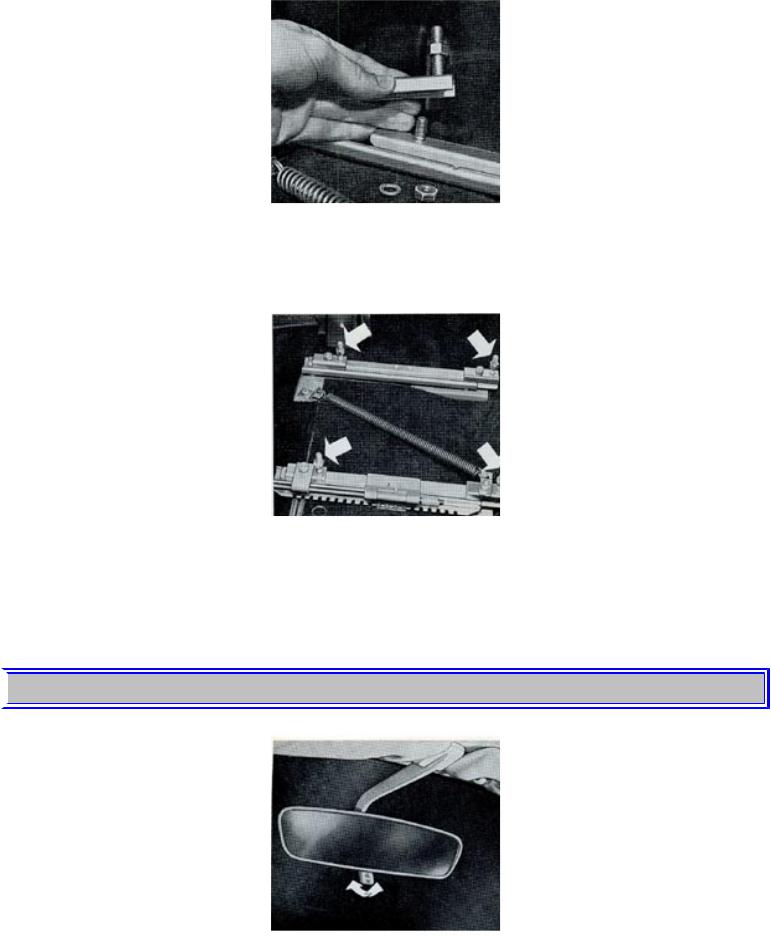
1973 Volvo 1800 ES
using the extra holes in the seat frame (see picture).
First remove the seat cushion to get at the four nuts securing the seat frame. There-after it is possible to move the seat to one of the other holes.
The seat can also be adjusted still further lengthwise with the help of the spacer sleeves on the slide rails. To do this, first remove the seat. Then release the nuts securing the spacer sleeves, lift up the spacer sleeve slightly and turn it half a turn.
Seat height adjustment
The seat can be adjusted vertically by means of the bolts and nuts on the slide rails. First, remove the seat cushion. Then release the upper nuts on the top side of the steel frame and adjust to the desired position with the nuts underneath.
The picture shows the seat removed. The arrows point to the lower adjusting nuts.
 pg. 20 OPERATING INSTRUCTIONS
pg. 20 OPERATING INSTRUCTIONS
http://new.volvocars.com/ownersdocs/1973/1973%201800/731800_01.htm (16 sur 28) [2013-03-14 11:51:48]
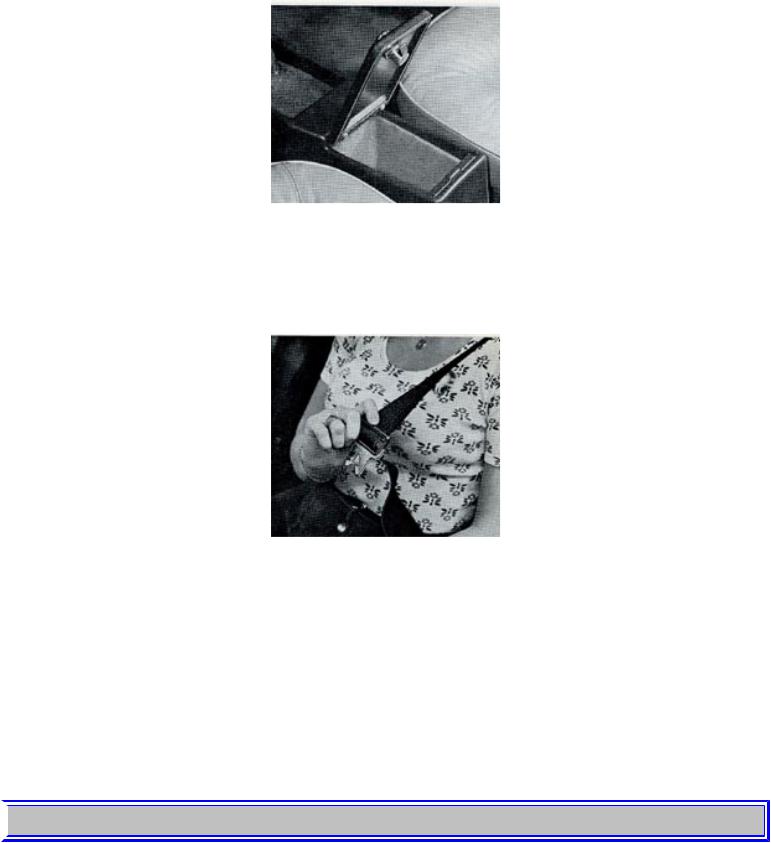
1973 Volvo 1800 ES
Rearview mirror
The interior rearview mirror is fitted with an anti-glare knob located in the lower edge of the mirror. To switch to anti-glare push back the knob.
Stow compartments
The 1800 ES is provided with two stow pockets, one on each of the doors. There is also a lockable stow compartment between the front seats.
The stow compartment has its own keys.
Seat belts
Always use the seat belt for all types of driving. Remember that it is possible even in slow city traffic to incur serious injury from sudden, unexpected stopping.
As a reminder that the seat belt should always be fastened before driving, a reminder light goes on and a buzzer is heard. The light goes out and the buzzer stops when the driver fastens his seat belt. See further page 12.
Automatically retracting seat belts
Your car is fitted with automatically retracting inertia seat belts.
To fasten the belt, pull out the strap slowly
 pg. 21 OPERATING INSTRUCTIONS
pg. 21 OPERATING INSTRUCTIONS
http://new.volvocars.com/ownersdocs/1973/1973%201800/731800_01.htm (17 sur 28) [2013-03-14 11:51:48]
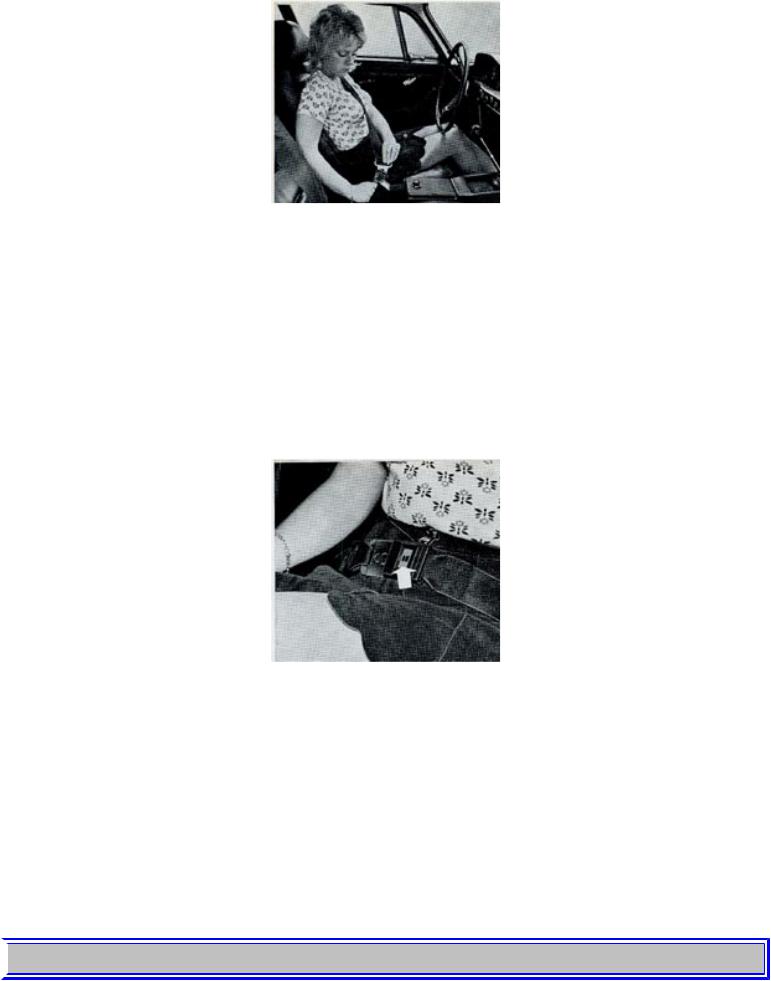
1973 Volvo 1800 ES
(with right hand for belt on left-hand side. with left hand for belt on right-hand side) to prevent the mechanism from locking. Normally the belt roller is "unlocked". The roller will lock automatically if pulled out quickly, or if the car brakes or inclines to an angle greater than 10-15° or when taking a bend rather sharply.
The practical design of the belt makes it very easy to use. Place the belt with one strap over the lap and the other across the shoulder - chest and fasten it by pushing the buckle tongue into the slot of the locking device located between the front seats. A loud clicking noise indicates that the tongue is securely locked.
Make sure that the sections of the belt in contact with the body are not twisted. The belt is released from the lock by pushing in the square red button on the lock. If the belts cannot retract fully, this may be due to the fact that they are twisted inside the cover casing. This is remedied by pulling out the belt fully and then allowing it to be drawn into the casing.
Seat belts in rear seat
Seat belts for two passengers are installed in the rear seat. The belts are fastened by pushing the buckle tongue on the one strap into the lock in the other. The belts are released by depressing the button in the lock and pulling the straps apart. The rear seat belts are of the automatically retracting type.
Do not let the belt lie on the floor otherwise it will become entangled and dirty as well as hinder getting in and out of the vehicle. Now and again check that the bolts anchoring the belt are properly tightened and that the belt is in good condition. Water mixed with some synthetic washing agent can be used for cleaning the belt. As the seat belts lose much of their strength when exposed to violent stretching, they should be replaced after collision, even though they may appear to be undamaged. Never modify or repair the belt on your own, but have this done by a Volvo workshop.
Note that small children (up to the age of 8-10 years) should not use the seat belts.
 pg. 22 OPERATING INSTRUCTIONS
pg. 22 OPERATING INSTRUCTIONS
http://new.volvocars.com/ownersdocs/1973/1973%201800/731800_01.htm (18 sur 28) [2013-03-14 11:51:48]

1973 Volvo 1800 ES
Keys
Three pairs of keys belong to the car: the ignition key, the key for the doors, which can also be used for the trunk and the fuel filler cap, and the key for the stow compartment between the seats. If you should happen to lose your keys, contact the nearest Volvo dealer for new ones and quote the code number of the keys which have been lost.
Doors and locks
The car is fitted with key locks on both doors.
The doors can be locked from the inside by moving the handle forwards.
They are also locked from the outside by first moving the handle on the inside forwards and then shutting the door. Do not leave the keys in the car.
The locks have been designed with a view to providing maximum possible protection against freezing during the wintertime. As an extra precaution, however, you should lubricate the locks regularly during very cold weather with a suitable anti-freeze agent. If the lock is already frozen, be careful not to break the key in the lock. Instead, heat the key and immediately insert it in the lock.
Ventilation window lock
To open the ventilation window, first slacken the small lock screw a couple of turns, push it in and then turn the handle upwards.
http://new.volvocars.com/ownersdocs/1973/1973%201800/731800_01.htm (19 sur 28) [2013-03-14 11:51:48]
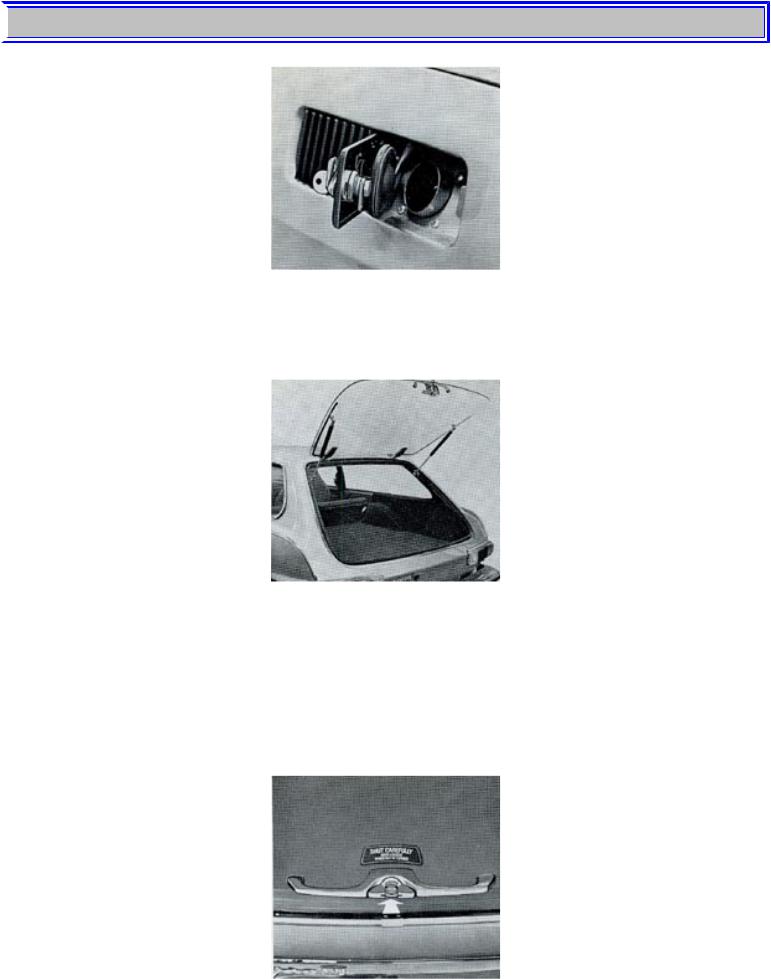
1973 Volvo 1800 ES
 pg. 23 OPERATING INSTRUCTIONS
pg. 23 OPERATING INSTRUCTIONS
Tank filler cap
The 1800 ES is fitted with a lockable tank filler cap. The keys for this cap are the same as the ones used for the doors.
Cargo space
The tailgate glass is opened with the same key as used for the doors.
The cargo space is accessible by raising the tailgate. This is made of glass so that a certain care should be observed when opening and closing it.
The cargo space has a light which goes on when the tailgate is opened.
Supplied with the car are two luggage fastening belts. These are attached to the anchorages on the inside wheel housings and at the rear of the cargo space.
Opening tailgate
http://new.volvocars.com/ownersdocs/1973/1973%201800/731800_01.htm (20 sur 28) [2013-03-14 11:51:48]
